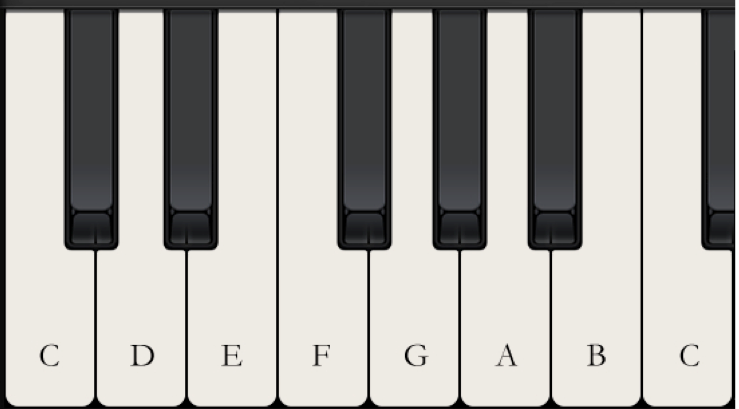Basic Music Theory
Don’t be shy about getting into some theoretical study. It is more fun than Soduko, easier than crosswords and unlike falling off a bike, which you apparently never forget, easy to retain and the bonus is that you are unlikely to get hurt.
It’s Easy
The first thing to understand is that music as a language is easy. There are many so called ‘methods’ that are promoted as being easier or simpler ways of learning but they are really not necessary.
Some important facts;
There are only 7 letters used ABCDEFG
On the keyboard you learn the position of these 7 letters and then they are repeated throughout the length of the instrument

Try this idea; note that the D sits between the two black notes. Find all of the letter D’s on the keyboard

Memorise one note each day and you have the complete keyboard learned in a week! Do you really need a cardboard cutout placed on top of the keyboard? On many occasions I have said to a student of mine ‘do you have the letter names shown on your keyboard’ they ask me how I know because in fact they do. The answer is that while the notes are named for you the brain does not have any encouragement to learn the notes. They do not know where the notes are while someone with no guide would have learnt them.
Copyright 2013 JBz Publishing
Reading Notation
There are two main elements here;
Pitch = the letter name that is to be played (how high or low the note is)
Time = How long to stay on a note before moving on to the next.
For reading Pitch we use a set of 5 horizontal lines we call a Stave or Staff and we use the lines and spaces to represent the notes’ Pitch.

We use mnemonics to help us learn to name these notes quickly, not because it is difficult as some people assume, it is just the Alphabet.
Pitch/The Note Names

They look a little random but they are in fact just the first seven letters of the alphabet A,B,C,D,E,F,G.
Here are some mnemonics.
Treble Clef lines, Every Good Boy Deserves Football
Treble Clef spaces, F A C E
Bass Clef lines, Great Big Dogs From Africa
Bass Clef spaces, All Cows Eat Grass
Copyright 2013 JBz Publishing
Quite often students are confused by the fact that the Treble and Bass clefs appear to be using different systems, they are not, they are in fact two parts of the whole system. Sometimes called a Grand Stave

Again just simple use of the Alphabet.
Time Values
There is a full list of time values at the back of the book but what you need to know here is that for most of the book the pieces use very simple time values

When counting we say the numbers evenly and add the word ‘and’ in between them when we see the plus sign +
If you listen to the recordings you will learn the time values naturally, they are very logical and there is no need to work on memorizing them. As the pieces progress to the Alberti Bass and Broken Chord versions the timing actually gets easier still as you just need to keep the left hand steady and place the right hand notes in the correct places.
There are other signs and symbols to learn but that is best done as you progress through the book.
Copyright 2013 JBz Publishing
